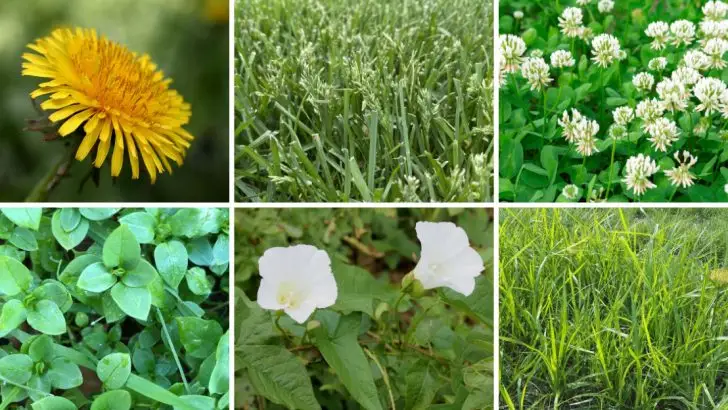Weeds have a way of showing up uninvited and overstaying their welcome. One day your garden or lawn looks tidy, and the next, it’s dotted with stubborn intruders that seem to grow faster than anything you actually planted. Some are easy to spot, others blend right in until they take over a whole patch. Either way, identifying them is the first step toward keeping them in check.
This guide breaks down 25 of the most common weeds you’re likely to come across in your yard. From the ones that spread low and wide to those that shoot up with surprising speed, we’ll cover what they look like and how to deal with them effectively—without relying on guesswork or trial and error. A little bit of knowledge goes a long way in staying ahead of these persistent plants.
Dandelion
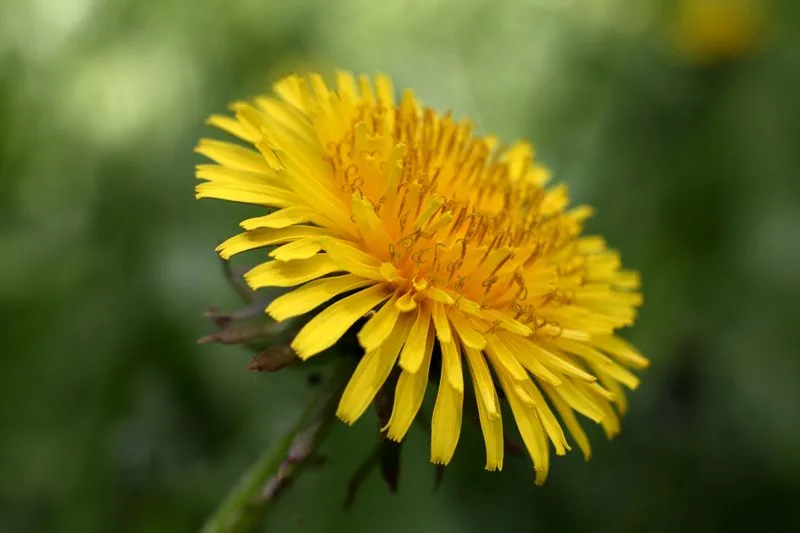
Dandelions, with their cheerful yellow flowers, are a common sight in lawns. These persistent perennials spread rapidly through wind-dispersed seeds. The deep taproot makes them tough to eliminate.
To control dandelions, regular mowing can reduce seed formation. Hand-pulling is effective if done before they seed. Using a broadleaf herbicide can help, but ensure it’s lawn-friendly to avoid harming grass.
Did you know? Dandelions are actually edible and packed with vitamins. They were originally introduced to North America for medicinal purposes.
Crabgrass

Crabgrass is the bane of many gardeners, known for its tenacious growth during hot summer months. It thrives in compacted soil, quickly overtaking weaker grass species.
Pre-emergent herbicides are effective if applied in early spring before the seeds germinate. Maintaining a thick lawn prevents its spread by depriving seeds of sunlight.
A fun fact: Crabgrass earned its name from the way its stems sprawl like crab legs. It’s an ancient plant, dating back to prehistoric times.
Clover
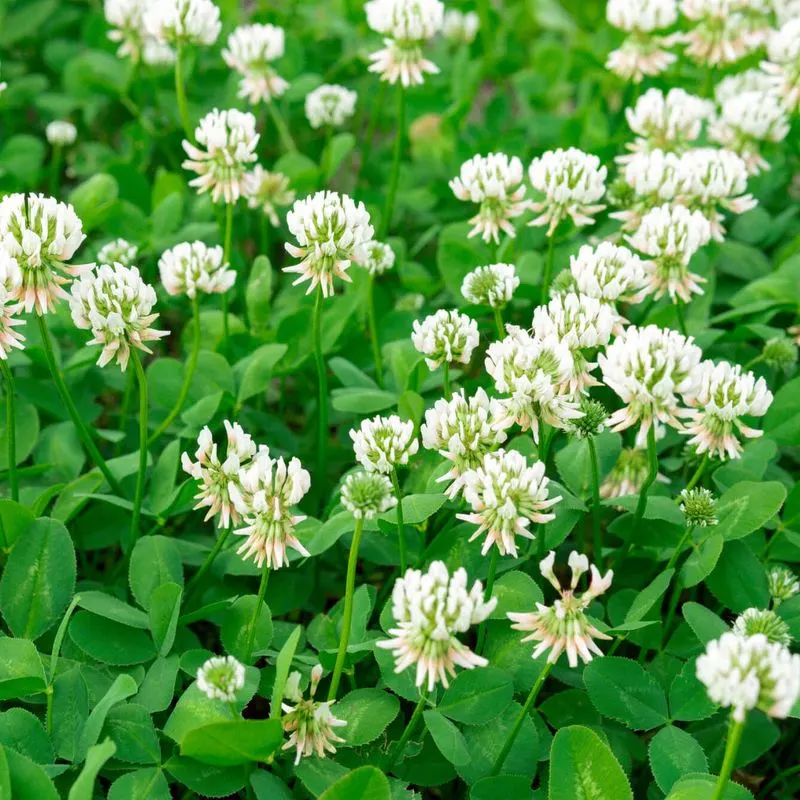
Clover, with its trifoliate leaves, is often seen as lucky but can swiftly dominate lawns. It’s nitrogen-fixing, which benefits the soil but can outcompete grass for space.
Frequent mowing and proper fertilization discourage clover growth. Selective herbicides specifically target clover without damaging grass.
Interestingly, many see clover as beneficial due to its soil-enriching properties. Historically, it was intentionally included in grass seed mixes for its benefits.
Chickweed
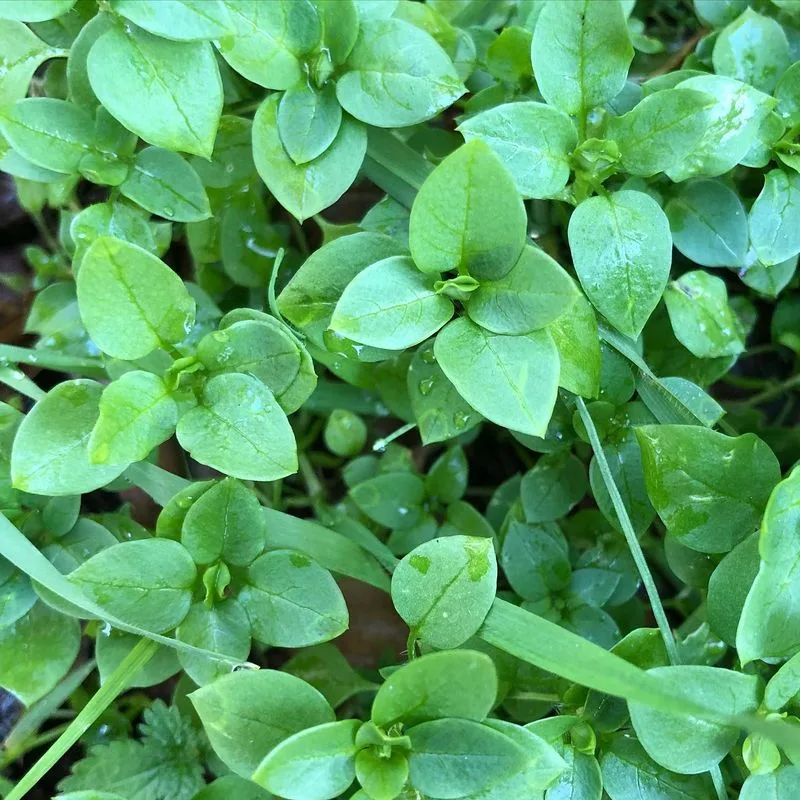
Chickweed is a low-growing plant with a reputation for rapid spread in cool, moist conditions. Its small white flowers are a telltale sign.
To manage chickweed, improve drainage and aerate soil to reduce moisture. Hand-pulling works if caught early, while post-emergent herbicides offer control in more severe cases.
Did you know? Chickweed leaves are edible and often used in salads. It thrives best in shaded gardens with rich, moist soil.
Bindweed
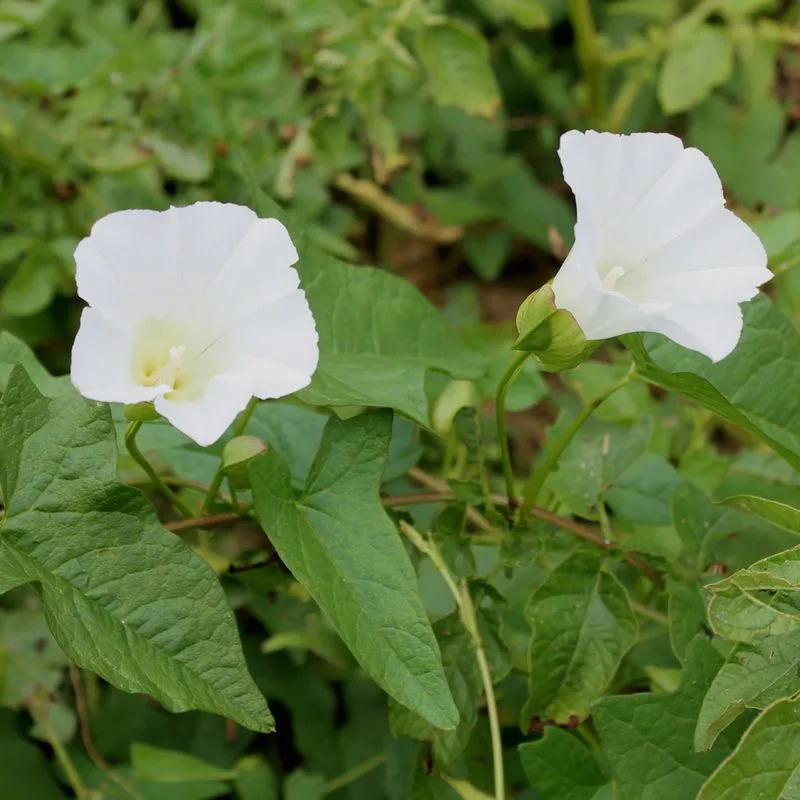
Bindweed, notorious for its twining growth, can choke other plants in its quest for sunlight. Recognizable by its trumpet-like flowers, it presents a persistent challenge.
Regular cutting back weakens bindweed over time. Applying systemic herbicides directly to its leaves can provide control, but persistence is key.
Fun fact: Bindweed is related to the sweet potato, sharing similar root structures, which contribute to its hardiness.
Nutsedge

Nutsedge stands out with its triangular stems and yellow-green hue, often mistaken for grass. Unlike grass, it flourishes in wet, poorly drained areas.
Effective control involves improving drainage and using selective herbicides that target sedges. Removing the tubers by digging is crucial as they store energy for regrowth.
Did you know? Nutsedge is sometimes called “nutgrass,” though it’s not a true grass. It’s known for creating dense patches that can disrupt lawn uniformity.
Ground Ivy
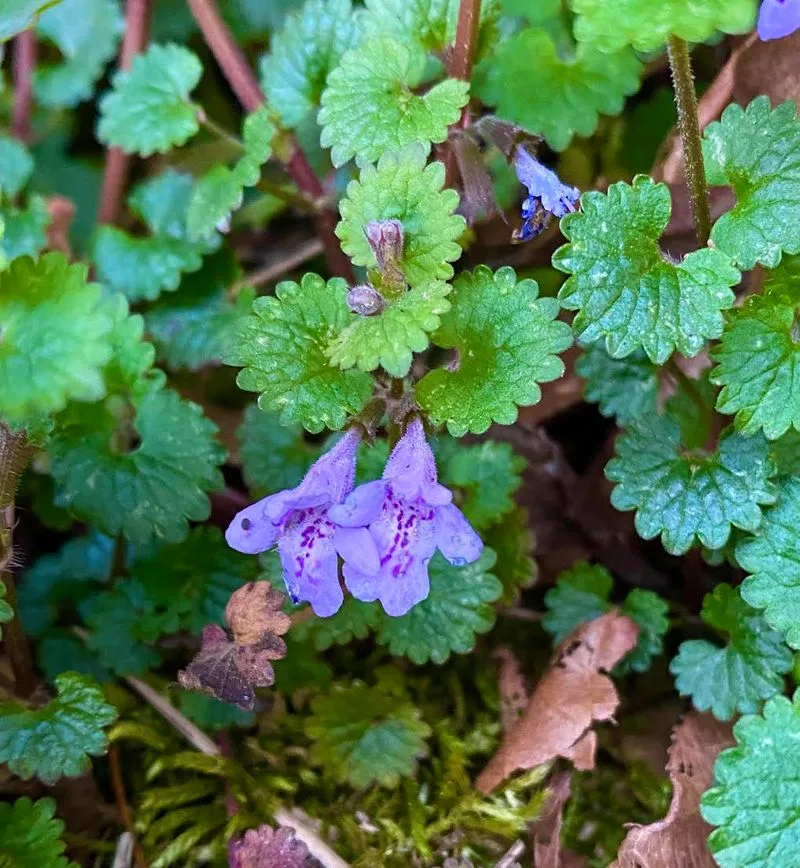
Ground ivy, or creeping Charlie, often carpets shaded areas with its mint-like aroma and purple blossoms. It thrives in moist, shady environments where grass struggles.
Aerating soil and improving sunlight exposure helps control ground ivy. Selective broadleaf herbicides can also curb its spread in lawns.
Interestingly, ground ivy was once used in brewing beer before hops became popular. Its creeping nature makes it both a historical and botanical curiosity.
Bermudagrass
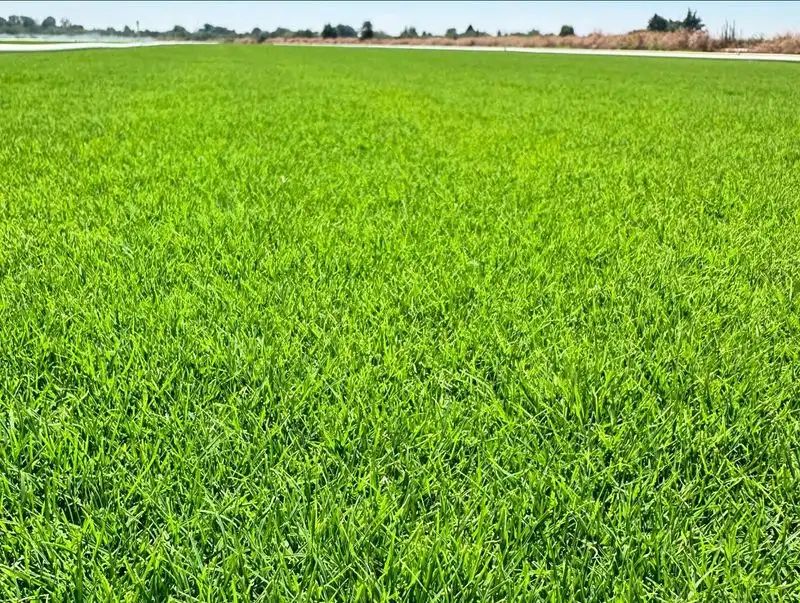
Bermudagrass, though often cultivated, can become a weed in cooler regions. Known for its aggressive growth and dense matting, it thrives in sunny, warm areas.
Regular mowing and edging keep Bermudagrass in check. Non-selective herbicides may be necessary for stubborn invasions.
Fun fact: Bermudagrass is native to Africa and thrives in tropical climates. Its resilience makes it a popular choice for sports fields but a nuisance in unintended areas.
Oxalis
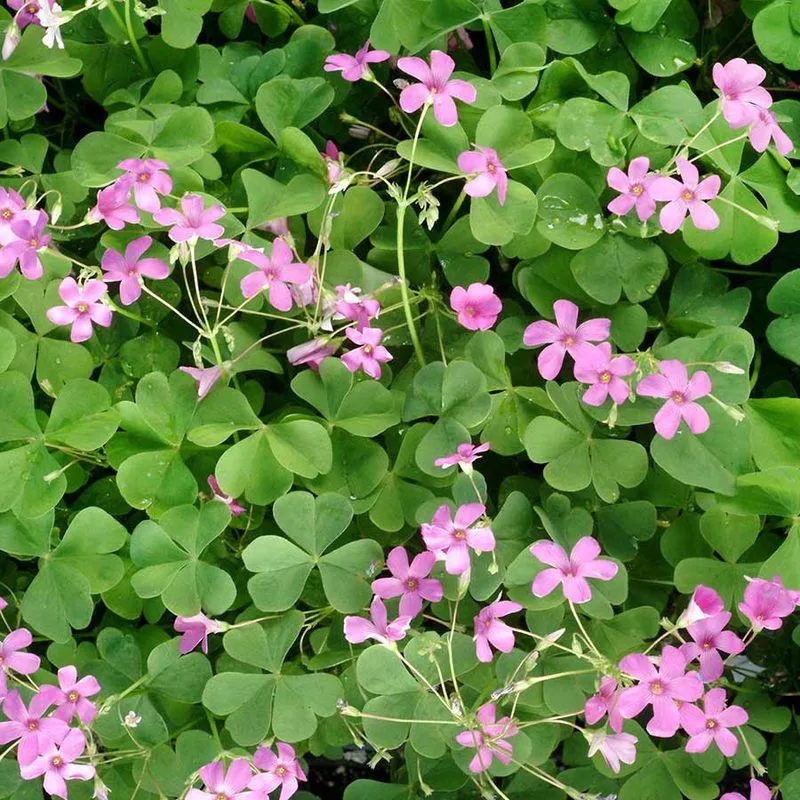
Oxalis, often mistaken for clover, features vivid yellow flowers and heart-shaped leaves. It flourishes in moist, well-drained soil, spreading through bulbs and seeds.
To control Oxalis, regular weeding and mulching help suppress its growth. Selective herbicides are effective against it without harming grass.
Did you know? Oxalis is also known as “sourgrass” due to its tart-tasting leaves, which are edible in moderation and add zest to salads.
Plantain
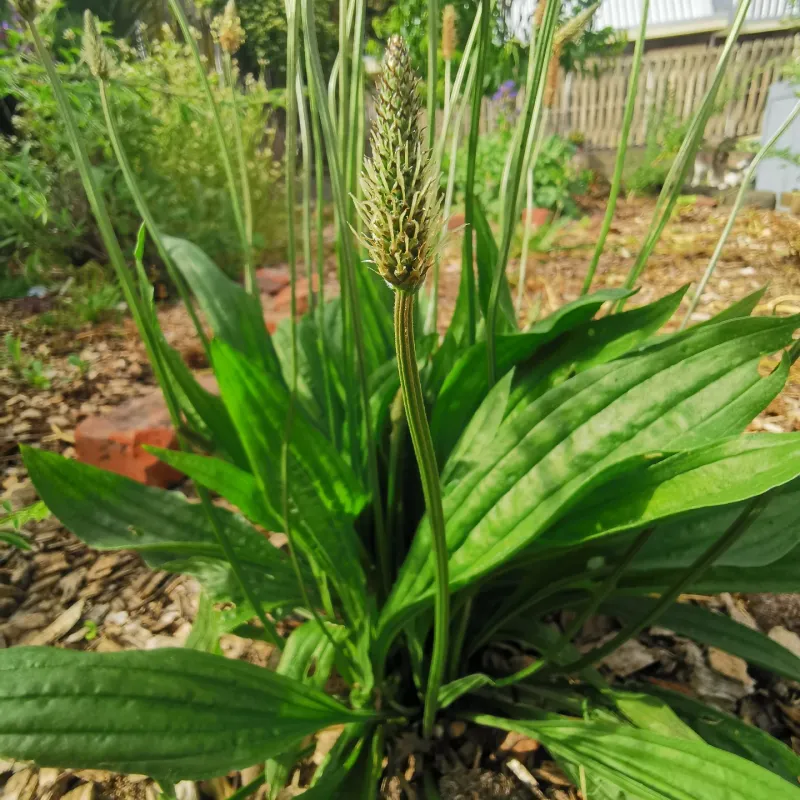
Plantain, not to be confused with the banana-like fruit, is a broadleaf weed with ribbed leaves and tall flower spikes. It thrives in compacted soil and poor lawn conditions.
Aerating soil and maintaining a healthy lawn can prevent plantain spread. Herbicides designed for broadleaf weeds are effective in control.
Interestingly, plantain has medicinal uses, often applied to cuts and stings for its soothing properties. It’s a weed with a history of practical benefits.
Thistle
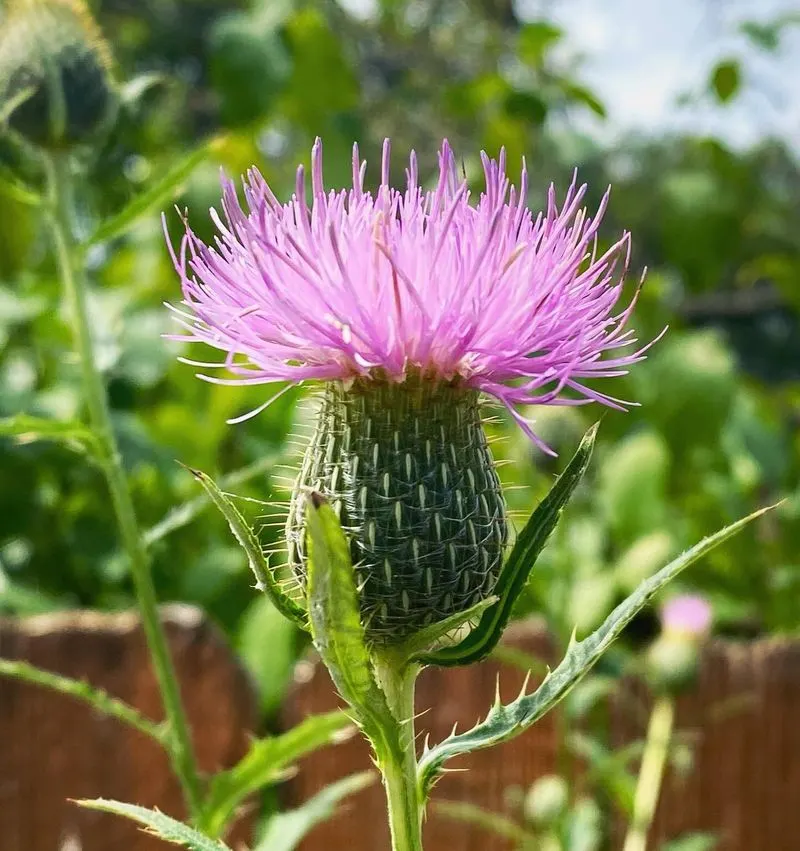
Thistle’s spiky leaves and purple flowers make it easily recognizable but unwelcome in lawns. Its deep taproot allows it to regrow if not removed completely.
To manage thistle, dig out the entire root system. Repeated mowing weakens the plant, and selective herbicides can assist where physical removal isn’t possible.
Fun fact: Thistle is the national emblem of Scotland, symbolizing resilience and defense. Despite its weed status, it’s appreciated in its native context.
Henbit
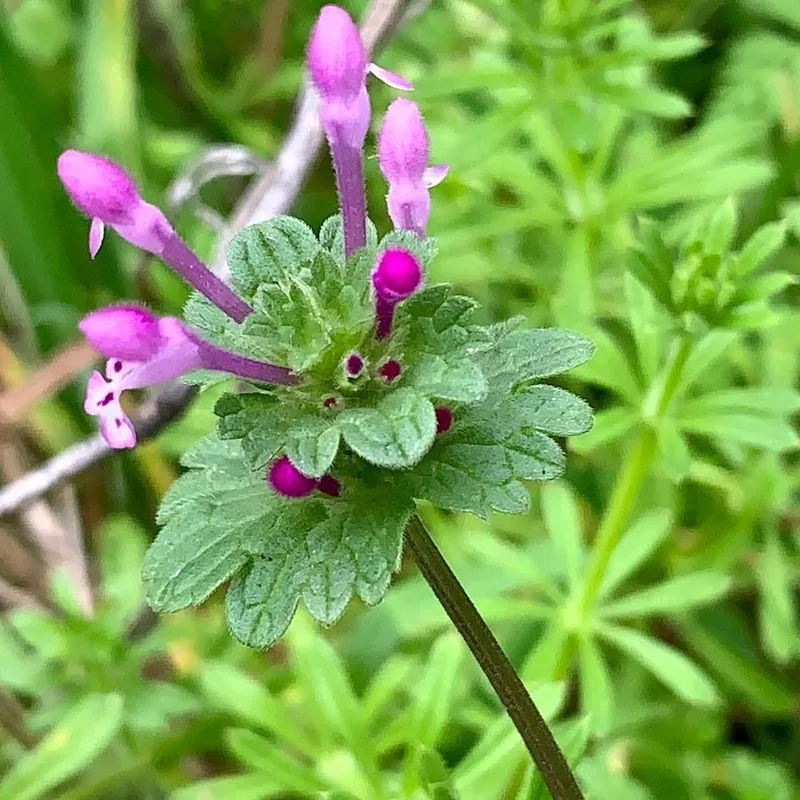
Henbit, with charming purple flowers, often covers gardens in early spring. Its square stems and scalloped leaves make it distinguishable.
Regular weeding before it flowers helps control henbit. Mulching can prevent seed germination, and post-emergent herbicides offer additional control.
Did you know? Henbit is part of the mint family, which explains its aromatic leaves. It’s edible and often used as a garnish in culinary dishes.
Purslane
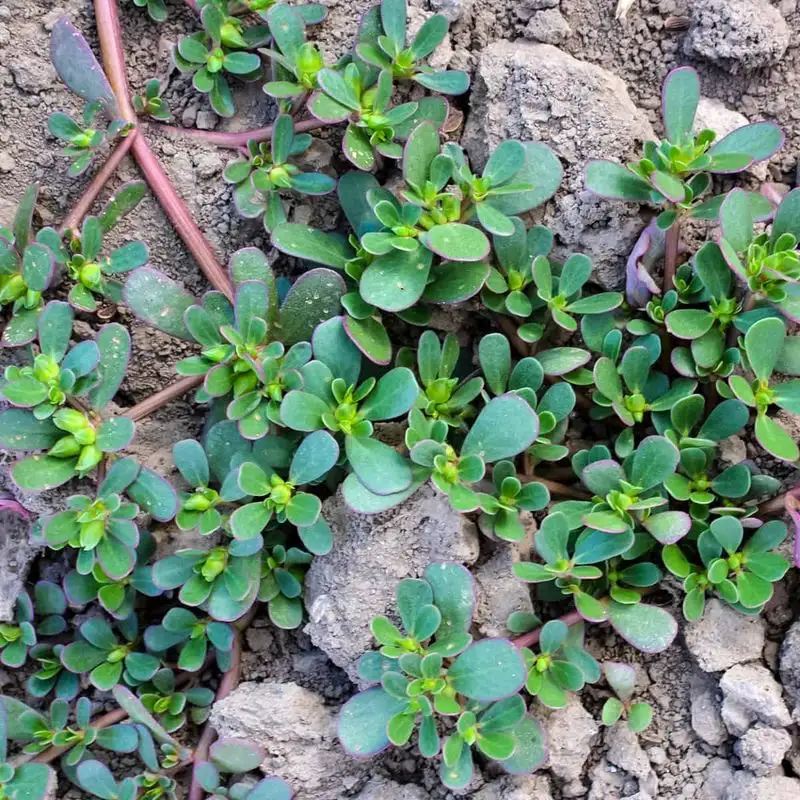
Purslane is known for its fleshy leaves and small yellow flowers, thriving in warm, dry conditions. Its resilience makes it a tough competitor for garden plants.
Hand-pulling can control purslane, especially before it seeds. Mulching and consistent watering can discourage its spread.
Fun fact: Purslane is high in omega-3 fatty acids and is considered a nutritious addition to salads, often seen more as a vegetable than a weed in some cultures.
Ragweed
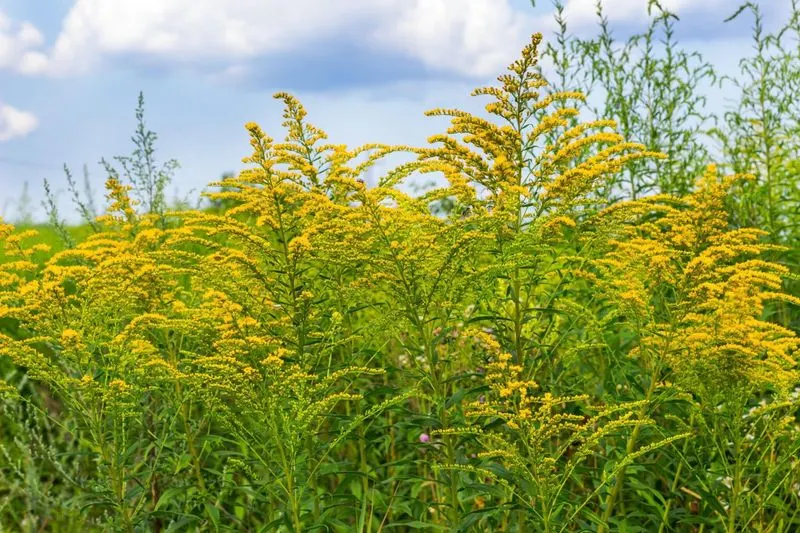
Ragweed, often implicated in seasonal allergies, is easily identified by its feather-like leaves. It spreads through seeds and thrives in disturbed soils.
Regular mowing before flowering and using broadleaf herbicides can help control ragweed. Keeping lawns healthy prevents its establishment.
Interestingly, a single ragweed plant can produce up to a billion pollen grains in a season, making it a notorious allergy trigger.
Foxtail
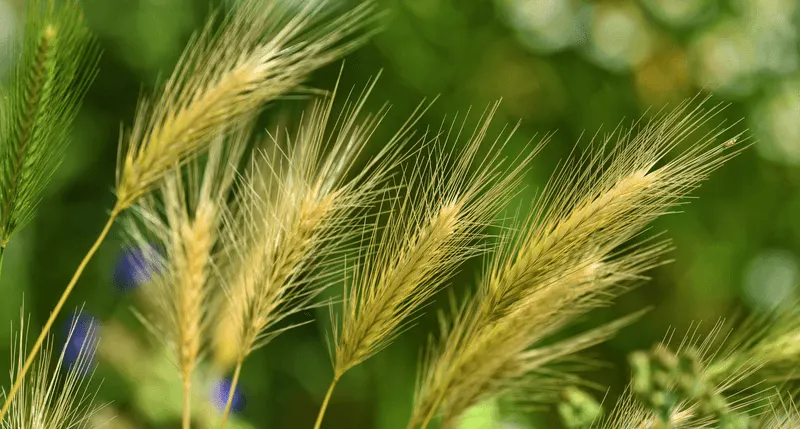
Foxtail, identified by its bushy seed heads, is a troublesome weed due to its rapid spread through seeds. It prefers open, sunny areas with dry soil.
Mowing before seed heads mature and using pre-emergent herbicides can reduce foxtail spread. Thickening your lawn through overseeding crowds out foxtail.
Fun fact: The seeds of foxtail can be dangerous to pets, as they can embed in skin or be inhaled, leading to infections.
Burdock
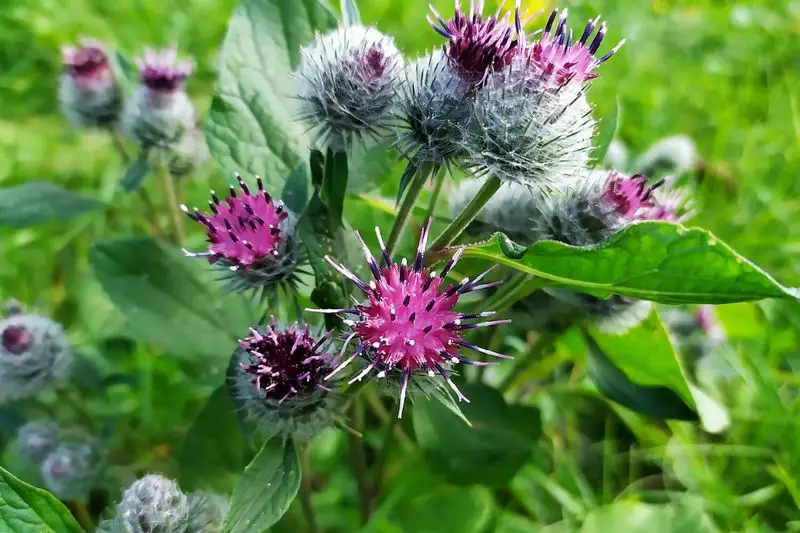
Burdock is notorious for its prickly burrs that cling to clothing and animal fur. The plant’s broad leaves make it easily recognizable.
Digging out burdock before it seeds is essential for control. Regular mowing and broadleaf herbicides can also prevent its spread.
Interestingly, burdock inspired the invention of Velcro. Its burrs’ hook-and-loop mechanism was the model for this ubiquitous fastening system.
Spurge
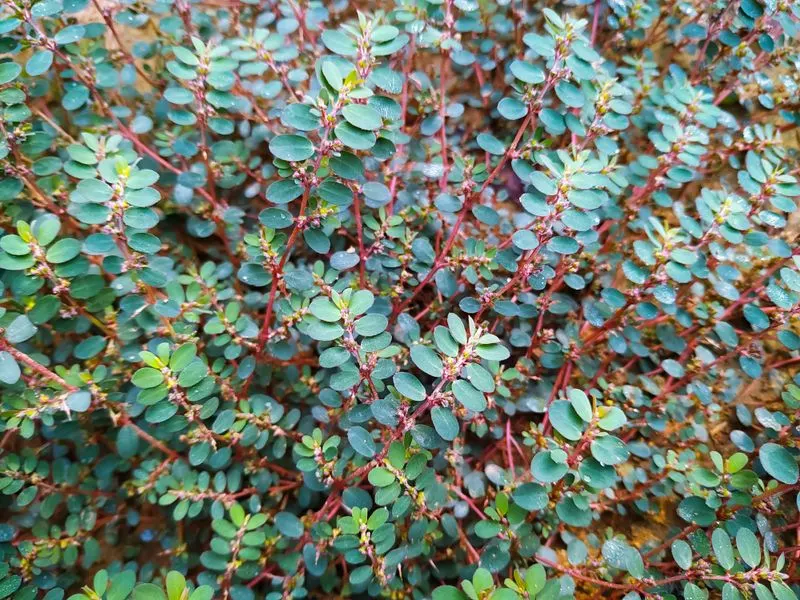
Spurge, with its low-growing, mat-like form, often invades gardens and lawns. It features milky sap that can irritate skin.
To control spurge, pull plants before they seed and use mulch to suppress growth. Herbicides are effective but must be applied carefully to avoid skin contact.
Did you know? The term “spurge” comes from the Latin word for “purge,” reflecting its historical use as a laxative, albeit with caution due to its toxicity.
Lamb’s Quarters
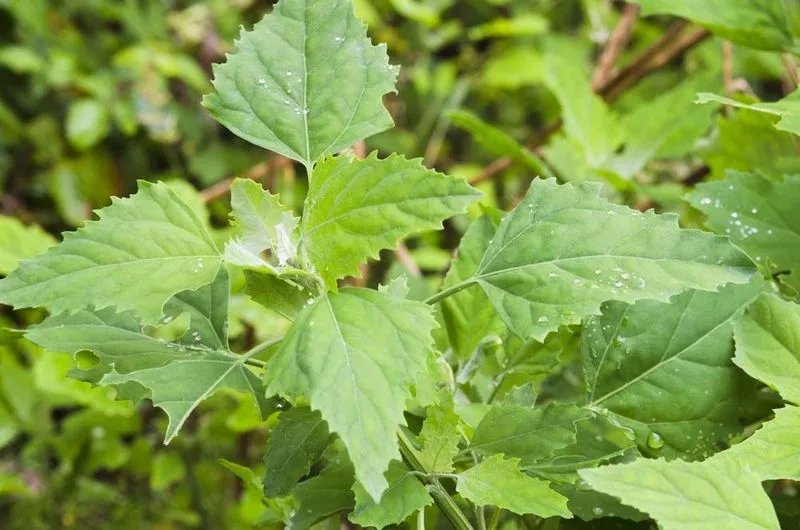
Lamb’s quarters, often found in gardens, is a tall weed with powdery, grey-green leaves. It thrives in disturbed soils rich in organic matter.
Maintaining a dense plant cover and regular weeding helps control lamb’s quarters. Pre-emergent herbicides may be needed for larger infestations.
Interestingly, lamb’s quarters is edible and high in nutrients, often touted as a “wild spinach” by foragers.
Velvetleaf

Velvetleaf is easily identified by its soft, velvety leaves and distinctive yellow flowers. It primarily invades agricultural fields, affecting crops.
Regular cultivation and targeted herbicide use help manage velvetleaf. Removing plants before they seed is crucial for control.
Fun fact: Velvetleaf was originally introduced as a fiber crop but became invasive across North America due to its prolific seeding ability.
Pigweed
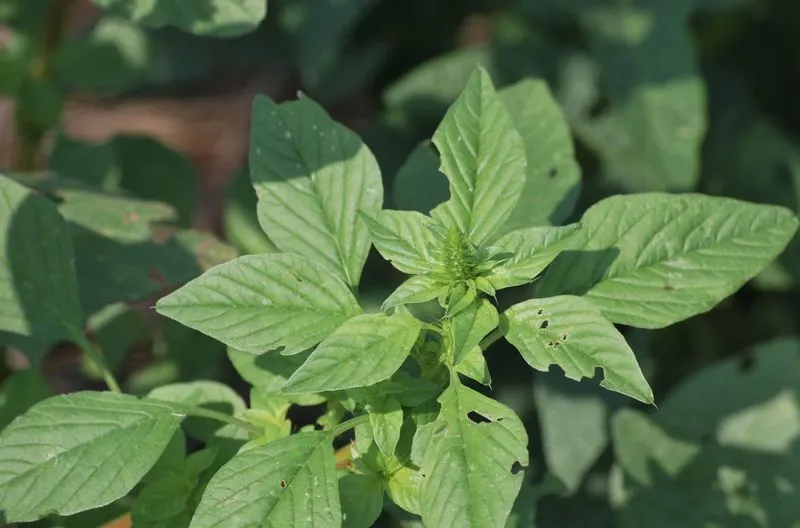
Pigweed, with its tall growth and reddish stems, is a common sight in fields and gardens. It competes aggressively for nutrients.
Maintaining soil health and using pre-emergent herbicides can help manage pigweed. Hand-pulling young plants before they seed is also effective.
Did you know? Pigweed seeds are edible and were a staple in Native American diets. It’s a weed with both historical and nutritional significance.
Speedwell
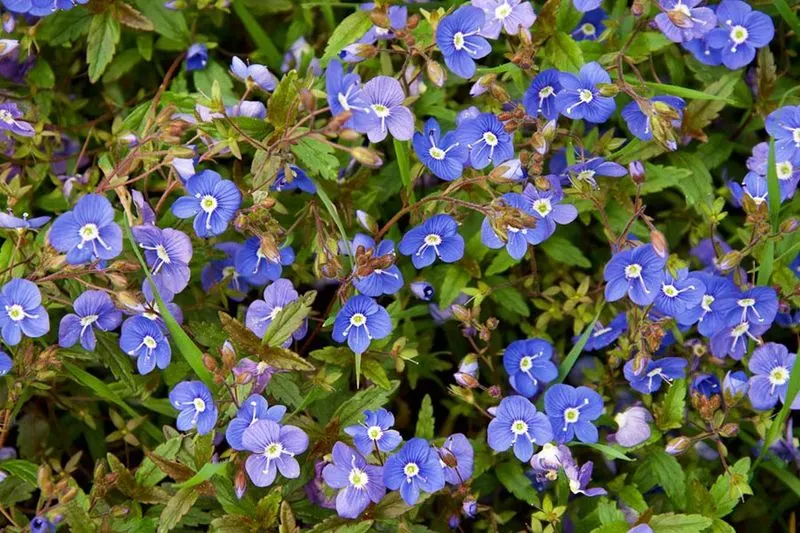
Speedwell, known for its tiny blue flowers, often creeps through lawns and gardens. It spreads through seeds and stolons, creating dense mats.
Increasing lawn density and using selective herbicides can curb speedwell. Regular mowing before it seeds helps prevent its spread.
Fun fact: The name “speedwell” derives from its historical use in medicinal remedies believed to “speed you well.” It’s a weed with a charming bloom.
Field Bindweed

Field bindweed, often called “creeping jenny,” is a perennial with twining stems and funnel-shaped flowers. It spreads through extensive root systems.
Persistent cutting back and applying systemic herbicides are necessary for control. Mulching can also suppress its growth.
Interestingly, field bindweed is related to morning glory, sharing similar floral structures. Its pervasive nature makes it a challenge for gardeners.
Quackgrass

Quackgrass, recognized by its coarse leaves and extensive rhizomes, can quickly overtake gardens. It’s often found in disturbed soils.
Maintaining a healthy, dense lawn and using non-selective herbicides can help manage quackgrass. Digging out rhizomes is essential to prevent regrowth.
Did you know? Quackgrass rhizomes were historically used in traditional herbal remedies, despite its reputation as a stubborn weed.
Yellow Nutsedge
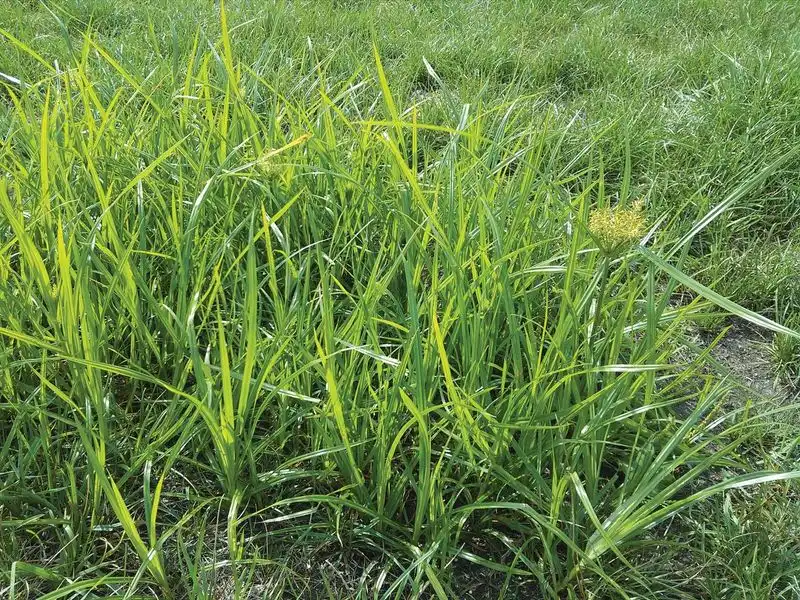
Yellow nutsedge, often mistaken for grass, is identifiable by its triangular stems and yellow-green leaves. It thrives in moist, poorly-drained areas.
Improving drainage and using nutsedge-specific herbicides can control its spread. Removing tubers prevents regrowth.
Fun fact: Although it resembles grass, yellow nutsedge is more closely related to papyrus. Its resilience makes it a formidable foe in lawns.
Bittercress

Often overlooked due to its diminutive size, Bittercress can quickly become a garden menace. This weed is easily identified by its small white flowers and rosette-forming leaves. Although delicate in appearance, Bittercress is a prolific seed producer, rapidly spreading if not controlled.
Regularly hoeing the soil or pulling young plants by hand can help manage its spread. Ensuring your garden soil is healthy and well-fertilized can also discourage its growth.
Did you know? Bittercress seeds can eject from their pods up to three feet away, launching the next generation across your garden.

